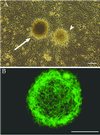Neural stem cell heterogeneity demonstrated by molecular phenotyping of clonal neurospheres
- PMID: 12381788
- PMCID: PMC137913
- DOI: 10.1073/pnas.212525299
Neural stem cell heterogeneity demonstrated by molecular phenotyping of clonal neurospheres
Abstract
Neural stem cells (NSCs) in vitro are able to generate clonal structures, "neurospheres," that exhibit intra-clonal neural cell-lineage diversity; i.e., they contain, in addition to NSCs, neuronal and glial progenitors in different states of differentiation. The present study focuses on a subset of neurospheres derived from fresh clinical specimens of human brain by using an in vitro system that relies on particular growth factors, serum, and anchorage withdrawal. Thirty individual and exemplary cDNA libraries from these neurosphere clones were clustered and rearranged within a panel after characterization of differentially expressed transcripts. The molecular phenotypes that were obtained indicate that clonogenic NSCs in our in vitro system are heterogeneous, with subsets reflecting distinct neural developmental commitments. This approach is useful for the sorting and expansion of NSCs and facilitates the discovery of genes involved in cell proliferation, communication, fate control, and differentiation.
Figures





References
Publication types
MeSH terms
Substances
Grants and funding
LinkOut - more resources
Full Text Sources
Other Literature Sources
Medical

